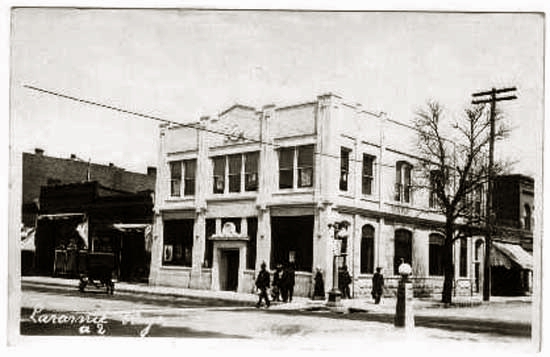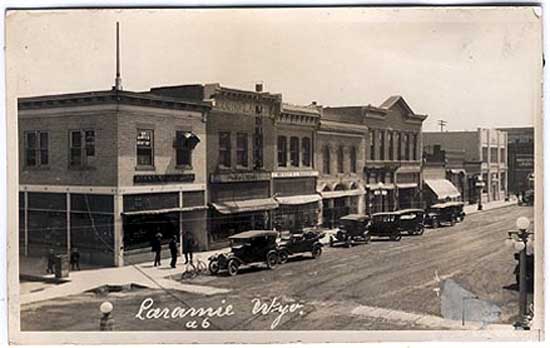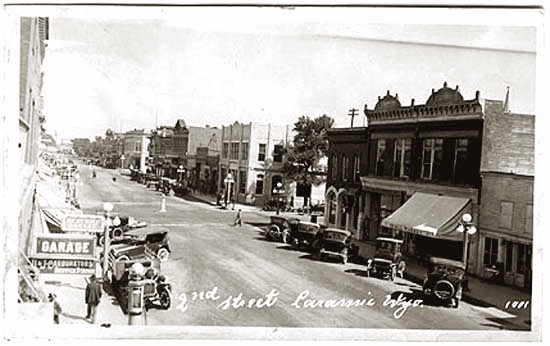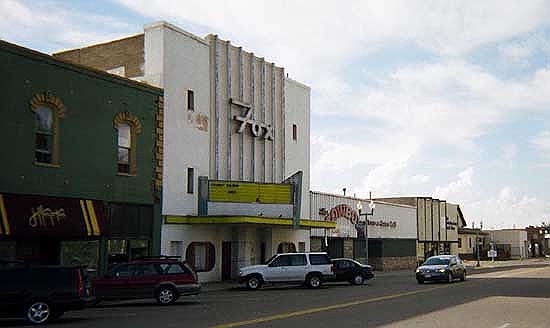
Albany National Bank of Laramie, 2nd Street, approx. 1920, photo by H.
Svenson
The Albany County National Bank was chartered in 1887 as the "Albany County National Bank of Laramie City and
changed its name to the "Albany National Bank of Laramie" in 1918. Additional views of the Bank
may be seen in the views of 2nd street below.
Svenson came to the United States from Germany in
1903 and joined his brother John Henning in Omaha in 1905. In 1905, he
opened a photography studio in Laramie. In addition to studio photographs he
made a number of photos in the 1920's documenting Laramie and its area.
The studio is still in business, operated by the fourth generation of the
same family. The American Heritage Center at the University of Wyoming maintains
over 20,000 negatives of photographs taken by the family. In addition to
photography, Svenson was a beekeeper, gardener and raised Belgian hares.

Second Street, approx. 1920, photo by H. Svenson

2nd Street, photo by H. Svenson
Located on Second Street, north of Ivenson Aveune was the Empress Theatre, Laramie's first movie palace.

Second Street, looking north toward the Empress Theatre, undated.
During the days of silent movies, the theatre featured its own orchestra to provide additional
thrills to the action upon the screen. Other early movie theatres in Laramie included Root's Opera House and the
American Theatre. But the Empress was a true palace. Admission was higher than the other two theatres: twenty-five cents to the auditorium and fifteen
cents to the balcony. The admission to H. E. Root's Opera House was ten cents.
The contractor for the construction of the theatre was the W. H. Holliday Co. at a contract cost of
$35,000. Throughout the summer of 1912 the Boomerang gave weekly updates on the progress of construction. In June the boomerang reassured its
readers that the latest fire protection methods were being utilized. The teatre included a large standpipe with hoses attached on the stage and
near the box office. The stage was separated from the auditorium by concrete and steel walls. An asbestos curtain could be dropped in th event of a fire to
further separate the stage from the auditorium. On September 4, the
plasterers were at work. On September 29, the brickwork was completed and the scaffolding was being removed all for an anticipated opening with the
"Prince of Tonight." At the last minute, the company cancelled out delaying the opening. Instead, the Shubert travling company of the
"Kiss Waltz" starring the Broadway musical sensation Valeska Suratt was booked in for the November 1 opening. On the grand opening day, the Boomerang reported a flury of activity.
The scenery shipped in from Denver was installed. The grand piano was tuned. The cast of the opening performance arrived by Pullman.
Congratulatory telegrams arrived from the manager of the Capitol Aveune and
Atlas Theatres in Cheyenne.

Empress Theatre, Second Street, undated.
The theatre had 850 seats icluding 432 on the parquet and dress circle, thirty-two boxseats and 204 reserved balcony seats in addition to
general admission. Two "colonial" stairways led up to the balcony level on which there was also a
ladies parlor. The interior was done in shades of tan and brown. The Boomerang noted that the stage was larger than
that of the Tabor in Denver. Below the stage in the "green room" were eight dressing rooms.

Empress Theatre, Second Street, 1913.
The building on the right where the Cowboy Saloon is now located is Steve Frazier's garage.
Show at the Empress typically included the feature film and a vaudeville act. Other live shows were put on. A five-piece orchestra provided
musical background for the movies.

Empress Theatre, Second Street, undated.
The second building to the right of the theatre with the automobile parked in front is Steve Frazier's Garage. Frazier sold
Dodge Brothers cars and trucks as well as Fisk "Non-Skid" tires..
During the 1918 influenza scare, all theatres and soda fountains were temporarily closed.
In 1938, the Empress temporarily closed for
remodeling and reopened in 1939 at the Fox Theatre with the front facade redone in an
art-deco style.

Fox Theatre, approx. 1940.
The Fox fell on hard times. It closed in 1975. Its roof went into a state of partial collapse, the
building was occupied only by pigeons. The pigeon droppings on the auditorium floor were a foot and a half deep.
Those entering the theatre were required to wear hazardous material suits.

Fox Theater, Second Street, 2005. Photo by Geoff Dobson
In 2008, due to danger to pedestrians, the sidewalk and parking spaces in front of the theatre were blocked off.
In the fall of 2009, the City completed demolition of the building.
Music this page:
Take Your Girlie to the Movies.
(On the mighty Hammond, courtesy of Horse Creek Cowboy)
Beatrice Fairfax gives advice,
To anyone in love;
That's why Johnny Gray,
Wrote to her one day;
'When I call to love my girl,
Her folks are always there;
That's why I'm blue,
What shall I do?"
And Beatrice said, "never despair"
Sweethearts always used to spoon,
In a big morris chair;
Young folks of today,
Have a different way;
Far away from cranky dad,
And mother's eagle eye;
It's lots of fun,
Here's how it's done,
So come on and give it a try.
Take your girlie to the movies,
If you can't make love at home;
There's not little brother there who always squeals,
You can say an awful lot in the seven reels.
Take your lessons at the movies,
And have love scenes of your own;
When the pictures over and it's time to leave,
Don't forget to brush the powder off your sleeve;
Take your girlie to the movies,
If you can't make love at home.
Take your girlie to the movies,
If you can't make love at home;
Pick a cozy corner where it's nice and dark,
Don't catch influenza, kissing in the park.
Take your lessons at the movies,
And have love scenes of your own;
Tho she's just a simple little ribbon clerk,
Close your eyes and think you're kissing Billie Burke;
Take your girlie to the movies,
If you can't make love at home.
Writer's note: "Dear Beatrice Fairfax" was the original "advice to the lovelorn" column written for Hearst's
New York Journal. The original column was written by Marie Manning (1872-1945) and served as a precursor
of similar columns such as "Dear Abby" and "Ann Landers."
|